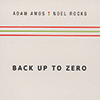
ADAM AMOS : NOEL ROCKS - Back Up To Zero
Private Label ARBR001
Back Up To Zero is essentially an album sharing collected experiences, an amalgamation of the writing talents and musicianship of Adam Amos (guitar) and Noel Rocks (banjo and guitar), who recorded two albums together in the 1980s. They toured extensively on the folk circuit throughout the UK and Europe for many years, only ceasing when Adam moved abroad… but now he’s back! One might assume that having been apart for so many years, there might be a musical reticence in finding the ‘sound’ that made them so popular when they first began their melodious journey together. However, rest assured, they fit like an old worn leather glove - soft, malleable and, above all, comfortable. The mellow production qualities of this album are superb throughout. The duo has assembled some fine musicians to support their endeavours, notably the renowned Su-a Lee on cello, whose mastery, along with the tonal qualities of the instrument, adds superlative depth and resonance. Noel’s banjo is subtle and a delight to listen to (for the ‘geeks’ out there he plays both a Deering and a Bart Reiter banjo, but not at the same time!).
The majority of the songs, with shared vocals, have been written either by Adam or Noel, with a smattering of additional material. If I have a criticism at all, there is a sense of homogenisation in terms of tempo concerning the whole. Personally, I would have liked some variation in style, if only to refocus the ear to engage with the material properly. The song that stands out head and shoulders above the rest must surely be If I Find A Way - a track in which Su-a Lee’s talents really come to the fore.
This is a pleasant addition to the duo’s previous work. Supporters and admirers from previous decades will not be disappointed and Amos and Rocks may well be attracting a new audience too!
www.amosandrocks.com
John Oke Bartlett
This review appeared in Issue 135 of The Living Tradition magazine
